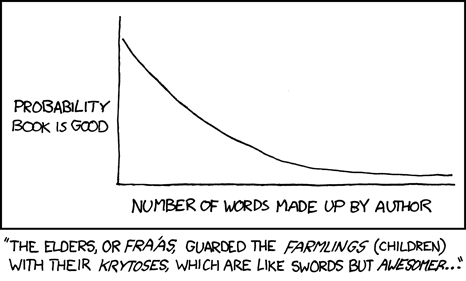Getting someone’s attention online is hard, but keeping their attention can be a nightmare. That’s why it’s so critical to improve your writing: because online readers click away at an alarming rate.
Consider this:
- 55% of readers spend less than 15 seconds on the average webpage
- Only about half of all readers ever reach the middle of an article
- 5-10% of visitors never even scroll down a page
In Google Analytics terms, this means most webpages have a high bounce rate, minimal time spent on-site, and more than half of all readers will exit before they ever see your call to action.
Or, if you’re writing fiction or journalism, it means nobody is finishing your story.
Why does this happen?
Mostly because we’re a nation of skimmers.
But every relationship is a two-way street, and the reader-writer relationship is no different.
Yes, readers can be easily distracted or click away due to Fear of Missing Out (FOMO). But writers are responsible for their own half of this problem too. The ugly truth is that most online writing just doesn’t deserve a reader’s full attention because it’s bad.
You know what I’m talking about, because you see it every day:
Clickbait. Fake news. Cheap listicles. Half-baked arguments. The web is filled with hastily-written, barely-edited content that’s designed to attract eyeballs for advertisers without satisfying the needs of the reader.
But that’s not what YOU want to write.
That’s why you clicked on this post: because you want to improve your writing.
You want to learn how to write stories, articles, and website copy that readers will actually finish, enjoy, and maybe even share.
So let’s do better than clickbait and word soup.
10 Tips to Improve Your Writing and Keep People Reading to the End
(NOTE: I’ll post the entire list first, for the skimmers. But if you want examples and practical advice on how to use all these tips, keep reading below the jump.)
- Start fast to build momentum
- Use mostly short paragraphs
- Bold the most important parts so skimmers won’t miss them
- Use a narrative to make your concepts tangible
- Create tension that must be resolved
- Data is useless without context
- Improve your writing by simplifying its reading level
- Break up any run-on sentences
- Use simpler words
- Make it shorter

Your reader’s thumb is forever ready to X out of the tab that contains your content. Don’t lose this thumb war!
#1: Start fast to build momentum
Be honest: when’s the last time you finished reading something that started out slow?
(And no, textbooks don’t count; I mean by choice.)
The truth is, when you open your story with a huge block of text, you invite people to close that tab and read something shorter instead.
Yes, you can write long articles, but you need to ease people into them. Start by making your story’s beginning as brief and painless as possible.
#2: Use mostly short paragraphs
Your writing’s quality partly depends on its flow. So if you want to improve your writing, go small.
Huge paragraphs feel like work. Avoid them.
We live in an era of tweets, texts, and YA fiction that’s written for near-zero attention spans. To avoid losing your audience in a pit of endless words, keep your paragraphs to 3-5 sentences max. Ideally, this will amount to 3 lines of onscreen text or less.
Also?
A sentence can be a paragraph all by itself.
So can a single word.
See?
#3: Bold the most important parts so skimmers won’t miss them
Do you have important information that you want to make sure even the skimmers notice?
Be sure to bold what you don’t want anyone to miss. That way your point will be clear even at a glance.

This girl is like two more sentences away from quitting your article and scrolling Instagram instead. Don’t lose her!
#4: Use a narrative to make your concepts tangible
A few years ago, I read an article about civil forfeiture.
If you’re not familiar with it, it’s a crazy law. It basically says the police can seize your property even if they only suspect you of committing a crime, and they don’t have to give it back even if you’re innocent.
Now, if I ask you what civil forfeiture is a week from now, you may have some vague recollection of that summary but you won’t necessarily recall it clearly. You may remember part of it, or you might even remember it wrong.
But if you had read the same article I read, you wouldn’t forget the story about the couple who was driving through Texas, got pulled over by a cop for no reason, and wound up having their car, cash, and infant son seized by police who were exercising civil forfeiture.
I may not recall the specifics of the law, but I remember its effects on people.
Readers can forget facts and figures. We’re fuzzy on how theories work. But we remember stories.
#5: Create tension that must be resolved
At its core, nearly every story boils down to three questions:
“What happened next?”
But for an audience to care about what happens next, they need to understand three things:
- What do the character(s) want?
- What’s preventing them from achieving their goals?
- What are the likely consequences if the characters don’t succeed?
One of the easiest ways to improve your writing is to increase the tension.
How?
Clarify the threat. Humanize the subject. Raise the stakes.
Obviously, fiction and biographies have a built-in advantage here.
You don’t have to like Rick Grimes or Jon Snow (who are, functionally, the same character) to be interested in finding out whether or not they live or die. That crucial “what happens next” tension is built into the very fabric of The Walking Dead and Game of Thrones right in their first scenes. It’s why we care about every character, from the heroic Michonne to comedic Samwell Tarly.
But if you’re writing an annual report, a landing page, or the marketing copy for a nonprofit donation request, your tension-building strategy is a little different.
In these cases, you may not have the luxury of a life-or-death narrative to fall back on, but you do have something else: you can raise tension by making your audience wonder what will happen if things go wrong.
What are they missing out on if they don’t buy your product?
What bad situation gets worse if they don’t give to your cause?
Who would be negatively affected if your organization ceased to exist?
Not every bestselling book is a linguistic masterpiece. But the Dan Browns and Ernest Clines of the world don’t need to be masters of language in order to hook their readers from beginning to end. Like you, they just need to be masters of managing their audience’s expectations.
You want someone to read longer? Make them desperate to find out what happens next.

Debating the merits of how to hook an audience with a more poetic title
#6: Data is useless without context
“45% of users abandon our shopping cart without completing a transaction.”
That statistic is just a data point.
From a functional point of view, it indicates that you have a problem, but by itself it isn’t actionable or correctable.
On the other hand…
“This is Amy. She’s a first-time visitor who clicked on our Facebook ad and then started to buy our product. Unfortunately, she gave up before she checked out.
“Meanwhile, this is Scott. Unlike Amy, Scott is a longtime fan of our brand. He’s on our email list, and he opens most of our emails. However, Scott has never completed a transaction either, even though he started five of them in the past year.
“That’s not even the worst part. The bigger issue? They’re not alone. Nearly half of our visitors do this.
“And now for the good news: here’s how we fixed it.”
With numbers, you just have data. With numbers plus examples, you have a story.
(And this is one story where your boss will definitely want to know: “what happens next?”)
#7: Improve your writing by simplifying its reading level
About 20% of all Americans read below a 5th-grade level.
That’s one in every five readers. But the other 80% of us aren’t seeking out complexity either.
According to the National Adult Literacy Survey (which seems to have been last updated in 2003, before we became an emoji and meme-based culture):
“The results show the average adult reads at the 9th-grade level. This accounts for the fact that popular blockbuster novels are written at the 7th-grade level: people like to read recreationally two grades below their actual reading skill. The average newspaper is written at the 11th-grade level, the tolerable limit for a 9th-grade reader.”
TL;DR? Write simply.
If people don’t understand what you’re saying, they won’t enjoy it or take action. That means they also won’t remember it, share it, or recommend it.
To really improve your writing, be sure your knowledge and expertise can be understood by as many people as possible.
How do you know what the reading level of your writing is?
One way is to check it on https://readable.io/ — it tells you how readable your text is and offers suggestions for improvement.
If you write in WordPress, you can also install the Yoast SEO plugin. It comes with an automatic text analysis process that strengthens your SEO and improves your readability at the same time.

You think editing is brutal? Wait until you watch someone close your story and never pick it up again.
#8: Break up any run-on sentences
Look, I know that sometimes you want to write a sentence that includes a lot of information, often separated by commas, because you have so many interconnected ideas in your head that you simply can’t bring yourself to write in shorter sentences that feel choppy and incomplete so instead you lean on conjunctions and commas and, when the mood strikes, even the occasional semicolon; but seriously, a sentence that’s this long will test the patience of even the most highly-engaged reader.
Avoid it.
#9: Use simpler words
Do you think you have to use big words in order to explain complex topics?
Nope.
Randall Munroe, author of webcomic xkcd, explains Einstein’s theory of relativity using only the 1,000 most common English words. He calls it The Space Doctor’s Big Idea. And it works.
If you want to follow Munroe’s example, here’s a text analyzer he built that highlights any English word that isn’t one of the 1,000 most-used. His fiction rule of thumb is also handy:
#10: Make it shorter
To be honest, this last tip depends on the purpose of what you’re writing.
As Noah Kagan at OkDork has shown, longer articles actually get shared more widely than short ones do. This probably has less to do with length than depth, since longer articles are more informative and useful by design, while shorter pieces serve more as lead-ins and follow-ups.
That said, the shorter your article is, the more likely someone will finish it by default.
So if you’re not trying to write an all-inclusive ultimate guide to your topic, you owe it to your readers to not drag things out longer than necessary.
When you’re done writing, go back through and shorten, contract, remove, and reduce.
On the first editing pass, check for grammar and errors. On the second pass, read for flow. As you go through your work, kill anything that slows you down or distracts from your main point.
Try to keep every paragraph to 3 sentences, and reduce your total word count by at least 10%.
Trust me, your readers will thank you in the end.
And when you improve your writing, they’ll actually get there.
(Hey: do you also want to read less bad writing? Then share this post with your fellow writers!)
If You Liked This Post
… then you may also like this one about how to hook readers at the beginning of your story, or this list of the best YouTube channels for storytellers.




2 Comments
Lundie · October 19, 2017 at 1:50 pm
Yes, I skimmed. Might go back and read – but the #1 thing that stops me is large photos breaking up lists. If I can’t skim the 10 things up front, I don’t bother with the detailed writing underneath. God forbid you force the list to a second page. No list has that much pull.
Now, back to the article to read later. :)
Justin · October 19, 2017 at 2:37 pm
Ha! That’s an interesting point. Thanks for the suggestion. I went back and added a list of all 10 items up front, just to make sure the skimmers don’t get lost. :)